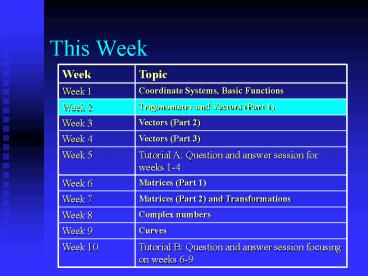This Week PowerPoint PPT Presentation
1 / 24
Title: This Week
1
This Week
2
Short Course in Mathematics and Analytic Geometry
- Week 2
- Trigonometry and Vectors
3
Radians
- A circle of radius equal to one is called a unit
circle. - On a unit circle, an angle measured in radians is
defined as the arc length this angle subtends. - Anticlockwise is
- positive radians
- Clockwise is
- negative radians
4
Arc Length and Area of a Sector
- In a regular circle, the arc-length is given as
- The area of a sector is given as
5
Trigonometric Functions
- Last week we looked at the three main
trigonometric functions
6
Trigonometric Inverse Functions
- In addition to these three functions are their
inverse functions
7
Trigonometry of Lines
- Consider the catheti used to determine the
Euclidean distance between points A and B - This implies the following relationship for
gradients
8
Trigonometry of Circles
- In a circle, the trigonometric functions have the
following relationships
9
Trigonometric Identities
- Consider the sine and cosine relationships about
a unit circle and the equation for a unit circle
with its centre at the origin - Substituting items on the left into the equation
on the right gives the trigonometric identity - Additional trigonometric identities
- http//www.members.optusnet.com.au/xyzrune/THQLect
ures/images/TrigonometricIdentities.pdf
10
The Law of Sines and Cosines
- Consider a general triangle with angles A, B, C
and corresponding sides a, b, c - The law of
sines - The law of
cosines
11
Vectors (Part 1)
- Scalars A scalar is a variable that only has
magnitude. It does not relate to any definite
direction in space. - Vectors A vector is a variable that has both
magnitude and direction
12
Vector Space
- A vector space is not an Euclidean space.
- A vector space can map onto an R2 space if two
special vectors i and j, called standard basis
vectors, are allowed to represent a unit of
magnitude along each axis, x and y
13
A Vector on R2
- Given standard basis vectors i and j on an R2
space, any vector v can be defined in terms these
standard basis vectors. For example
14
A Vector on 3D
- As with Euclidean space, a vector space can be
extended to higher dimensions
15
Properties of Vectors
- Given two vectors
- Vector v is equal to w if and only if
- Given a is a scalar, the scalar product of a
vector v is
16
Properties of Vectors
- The sum of vectors v and w is
17
Properties of Vectors
- The difference between vectors v and w is
18
Magnitude of a Vector
- The magnitude of a vector v is given by the
notation v . - On a Euclidean space, the magnitude is given by
the Euclidean distance formula
19
Unit Vectors
- Quite often the direction of a vector is more
important than the magnitude. Any vector can be
generalized to a vector of unit length, called a
unit vector - That is
20
Standard Basis Vectors
- Properties of the Standard Basis vectors
21
Dot Product
- Note The dot product of two vectors is always a
scalar.
22
Angle between Vectors
- The dot product may be used to calculate the
angle between two non-zero vectors
23
Orthogonal Vectors
- If the angle between two non-zero vectors is ?/2
then the vectors are said to be orthogonal
24
Next Week
- Vectors (Part 2)

